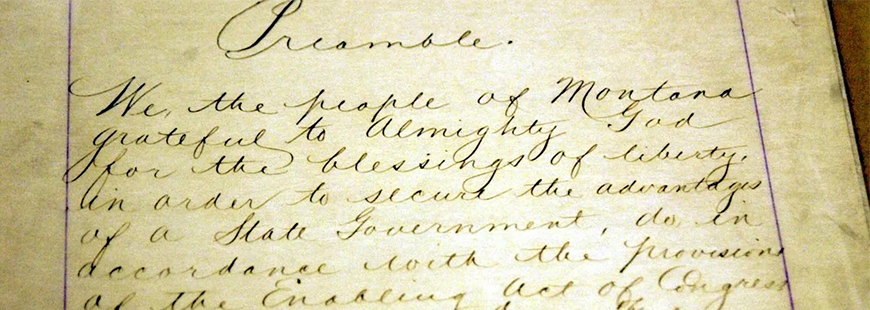II.6 Freedom of Assembly
Text
"The people shall have the right peaceably to assemble, petition for redress or peaceably protest governmental action."Mont. Const. art. II § 6.
History
Sources
1884 Proposed Montana Constitution
The 1884 Proposed Montana Constitution provided for the freedom of assembly:
"The people shall have the right peaceably to assemble for the common good, and to apply to those invested with the powers of government for redress of grievances by petition or remonstrance."Proposed 1884 Mont. Const. art. I § 24: https://archive.org/stream/montanaconstitutmontrich#page/6/mode/2up
1889 Montana Constitution
The 1889 Montana constitution was ratified to include the exact same language as the proposed 1884 constitution:
"The people shall have the right peaceably to assemble for the common good, and to apply to those invested with the powers of government for redress of grievances by petition or remonstrance."1889 Mont. Const. art. III § 26.
The freedom of assembly was accompanied by an explanatory note expressly prohibiting assembly aimed towards violence: "A MEETING OF THE PEOPLE having a tendency to force and violence or any apparent tendency therto or such as to inspire terror, as being armed, making threatening or violent speeches and the like, is unlawful."1889 Mont. Const. art. III § 26: http://www.umt.edu/media/law/library/MontanaConstitution/Miscellaneous%20Documents/1889_const.pdf
Federal Constitution
The federal freedom of assembly is derived from the First Amendment: "Congress shall make no law respecting an establishment of religion, or prohibiting the free exercise thereof; or abridging the freedom of speech, or of the press; or the right of the people peaceably to assemble, and to petition the Government for a redress of grievances."U.S. Const. amend. I.
Colorado Constitution
Montana's 1884 and 1889 freedom of assembly language appears to be taken word for word from Colorado's 1876 Constitution:
"The people have the right peaceably to assemble for the common good, and to apply to those invested with the powers of government for redress of grievances, by petition or remonstrance."Colo. Const. art. II, § 24.
Drafting
The 1972 Constitutional Convention Bill of Rights Committee proposed the 1889 language be changed to: "The people shall have the right peaceably to assemble, petition for redress or to protest governmental action."Montana Constitutional Convention, Bill of Rights Committee Proposal No. VIII, 19 (Feb. 24, 1972) https://archive.org/stream/billofrightscomm08montrich#page/18/mode/2up The committee unanimously recommended the freedom of assembly from the 1889 constitution be adopted with their minor stylistic changes. In doing so, the committee recognized the paramount function freedom of assembly played in a democratic society.Id.
At the Committee of the Whole hearing, Delegate McNeil proposed adding the word "peaceably" before "protest governmental action."1972 Montana Constitutional Convention, Verbatim Trans. 1647 (Mar. 7, 1972). Without "peaceably," Delegate McNeil was worried the freedom of assembly would imply the right to violently protest governmental action.Id. at 1648. The discussion following Delegate McNeil's proposed amendment was merely over grammar: members of the Bill of Rights Committee made it clear they intended the freedom of assembly to apply solely to lawful, peaceful action.See id. at 1648–49. In the end, the Committee of the Whole unanimously recommended the freedom of assembly, with Delegate McNeil's amendment, be adopted.Id. at 1649.
The Committee of Style, Drafting removed Delegate McNeil's "peaceably" and modified the grammar of the section in their final recommendation to the convention.Montana Constitutional Convention Proceedings, Vol. II, 963. However, once presented to the convention as a whole, the second "peaceably" was once again added to the language.1972 Montana Constitutional Convention, Verbatim Trans. 2481 (Mar. 16, 1972). Some delegates were concerned the committee of style's amendments would change the meaning of the 1889 constitution, which they intended to transfer to the 1972 constitution.See id. at 2477–81. However, all the delegates were in agreement as to the intended meaning of the freedom of assembly, their disputes revolved solely around grammatical structure.Id. In the end, the convention voted unanimously to adopt the Article II, Section 6 we have today.Id. at 2481.
Ratification
The Freedom of Assembly was ratified by the people of Montana as part of the proposed constitution. The 1972 Voter's Pamphlet noted no changes from the 1889 constitution except grammar: "Retains basic rights to assemble and petition or protest for redress of grievances."http://www.umt.edu/law/library/files/1972voterspamphlet
